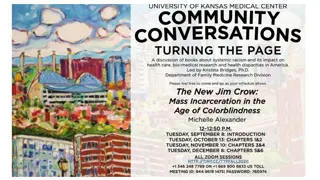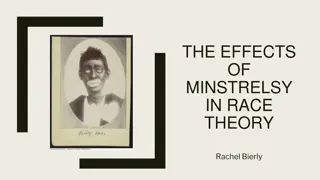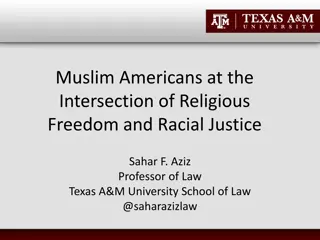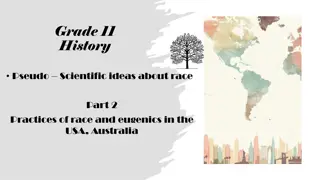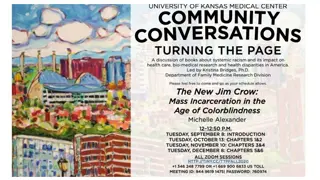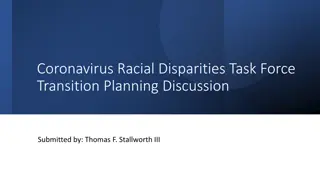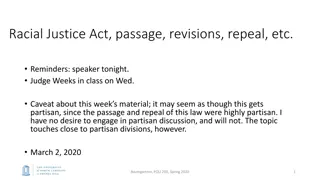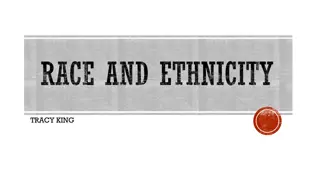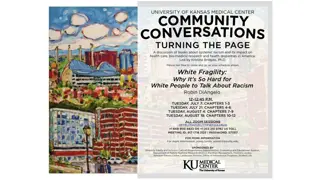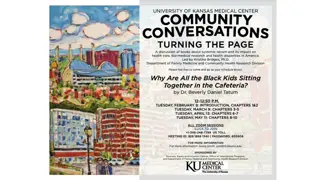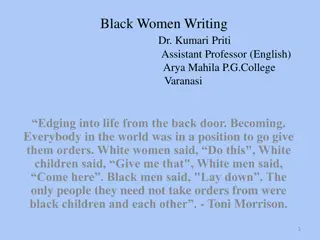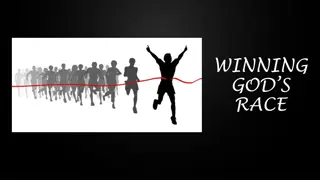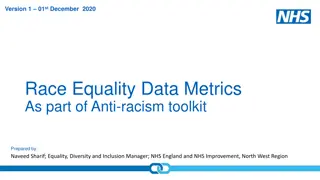Exploring the History of Race Classification and Racial Categories
Delve into the historical context of race classification through the lens of notable figures like David Hume and Johann Friedrich Blumenbach. Uncover the evolution of racial categories in U.S. Census data, from 1850 to 1930. Reflect on the implications of these classifications in society and learn about various racial groups and their definitions.
Download Presentation

Please find below an Image/Link to download the presentation.
The content on the website is provided AS IS for your information and personal use only. It may not be sold, licensed, or shared on other websites without obtaining consent from the author. Download presentation by click this link. If you encounter any issues during the download, it is possible that the publisher has removed the file from their server.
E N D
Presentation Transcript
THE CREATION OF RACE THE CREATION OF RACE
Classify Your Class As a group classify your class. Use characteristics to make smaller more specific groups within your class just like Linnaeus created his classification system from broad (domain) to most specific (species).
Discussion Questions What characteristics did you emphasize? Why? Look at your classification system. What types of groups did you create? What is race? Define the different racial groups. (HINT: What are race options when you take standardized tests, fill out applications, etc.) How does the U.S. classify its citizens today? Give examples. http://www.pbs.org/race/002_SortingPeople/002 _00-home.htm
Previous U.S. Census Data Previous U.S. Census Data Racial Categories Racial Categories 1850 Blank = White B = Black M = Mulatto 1930 W = White N = Negro Mex = Mexican In = Indian Ch = Chinese Jp = Japanese Fil = Filipino Hin = Hindu Kor = Korean 1900 W = White B = Black Ch = Chinese Jp = Japanese In = American Indian
Retrieved from http://www.scotland.gov.uk/Publications/2005/06/22110457/05032
Classification of Humans David Hume- I am apt to suspect Negros and in general all other species of men are inferior to whites Linnaeus- Classifying all living organisms Retrieved from http://upload.wikimedia.org/wikipedia/commo ns/1/1c/Allan_Ramsay_- _David_Hume,_1711_- _1776._Historian_and_philosopher_- _Google_Art_Project.jpg
Johann Friedrich Blumenbach (1779) German scientist who classified humans Measured human skulls [Blumenbach believed] the peoples of the world could be studied by the rules of objective science and then carefully ranked. [To him] race . . .was a method for mapping out the natural order of the world, which ran down from light to dark [skin] (Aronson 126). Retrieved from http://commons.wikimedia.org/wiki/File:JF_Blumenbach.jpg
See this chart on p. 119 of Race Retrieved from http://www.dailystormer.com/wp-content/uploads/2013/11/races_skulls.jpg
Retrieved from http://www.understandingrace.org/images/482x270/science/one_race.jpg
Retrieved from http://www.beingencouraged.com/wp-content/uploads/2012/11/5-Races-Classification.png
Findings 5 Races Caucasians- original human beings Oldest and most beautiful Asians- yellow Malay- brown transitional form American Indians- red transitional form Africans- Black- most altered
Findings Race was not just skin tone, eye shape, and hair type it was a way of ranking men which ran from Lightest to dark. Light being most superior.
One Result of Classification based on Reason? NEGRO Encyclopedia Britannica, 1798 NEGRO, Homo pelli nigra, a name given to the variety of the human species, who are entirely black, and are found in the Torrid zone, especially in that part of Africa which lies within the tropics. In the complexion of negroes we meet with various shades; but they likewise differ far from other men in all the features of their face. Round cheeks, high cheek-bones, a forehead somewhat elevated, a short, broad, flat nose, thick lips, small ears, ugliness, and irregularity of shape, characterize their external appearance. The negro women have the loins greatly depressed, and very large buttocks, which give the back the shape of a saddle. Vices the most notorious seem to be the portion of this unhappy race: idleness, treachery, revenge, cruelty, impudence, stealing, lying, profanity, debauchery, nastiness and intemperance, are said to have extinguished the principles of natural law, and to have silenced the reproofs of conscience. They are strangers to every sentiment of compassion, and are an awful example of the corruption of man when left to himself.
Questions: With technology today, how do we classify organisms? genetics or DNA Do you think the person most like you in this room is of the same race? Move into groups based off these other genetic characteristics The Difference Between Us Link Start at 1:15 5:45 DVD Start at beginning with the opening titles (00:45 - 05:23; DVD Scene #2)
Inherited Trait Yes No Tongue Curl Detached earlobe Hitchhiker s thumb Lactose Intolerance Widows Peak Cleft Chin Right vs Left Handiness Fingerprint type (Whorl vs Arch vs tented arch) Blood type ( A, B, AB, O) Hand clasp (right thumb vs left thumb on top) Freckles Allergies
Follow-up Questions How did your groups differ compared to your original groups for classification? Would it be easier to categorize humans if you used more traits? Why or why not? The Difference Between Us (Finish on the link) Start at 33:27 36:20
Why is it dangerous to focus on one characteristic Ethnocide: intentional and systematic destruction of an ethnic culture Genocide: the deliberate and systematic destruction, in whole or in part, of an ethnic, racial, religious, or national group Eugenics: the study of or belief in the possibility of improving the qualities of the human species or a human population, especially by such means as discouraging reproduction by persons having genetic defects or presumed to have inheritable undesirable traits
Prenatal testing: is it Eugenics? Allow parents to know potential risk of fetus PKU Chromosomal disorders Sickle Cell Anemia Heart defects What are the eugenic consequences of prenatal testing why are some individuals morally opposed to it?
MaterniT21 Find the article excerpts on Blackboard (NEED TO PUT ASSINGMENT UP) Questions to consider: What are the positive aspects of a blood test that allows for detection of chromosomal abnormalities? What is the negative consequence? In your own words, using textual evidence, describe how prenatal testing is a form of eugenics. What are the consequences in society of these types of prenatal tests? Do you consider this to be negative or positive provide textual evidence to support your answer. You may want to use the link to the full article for more information.



